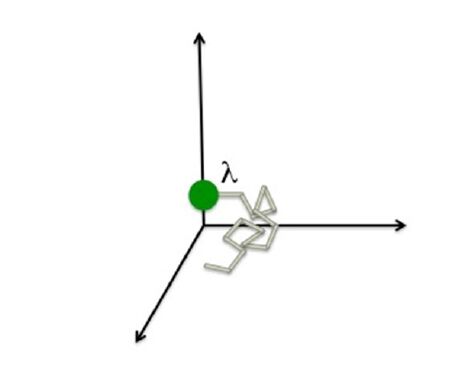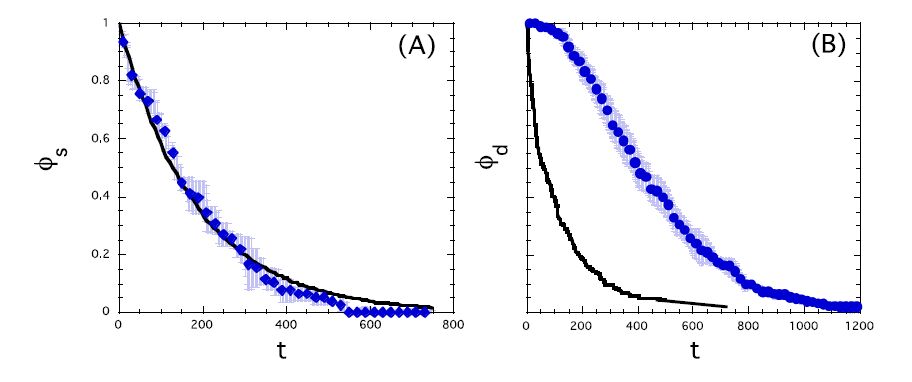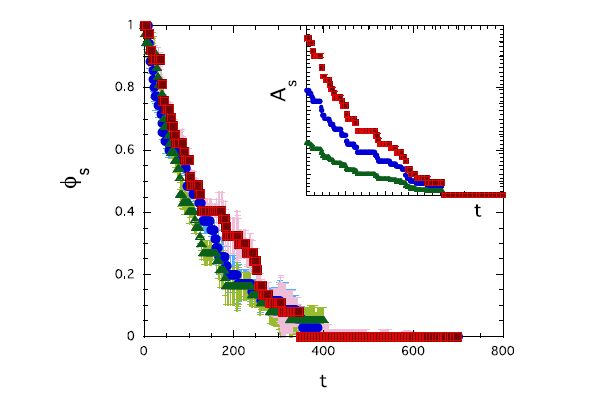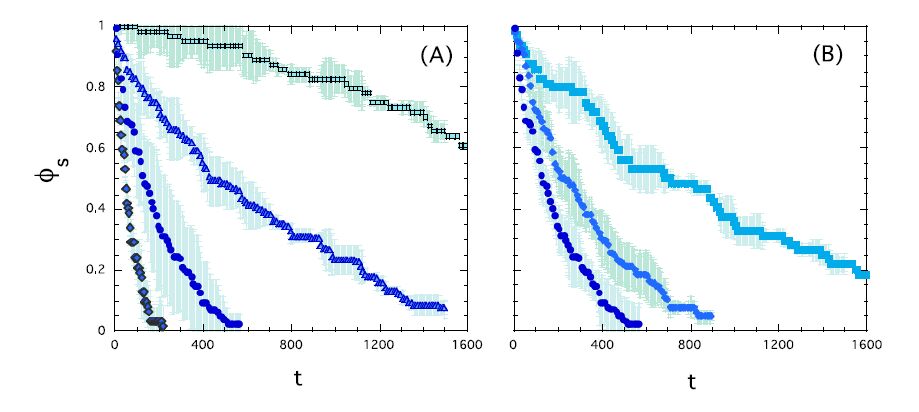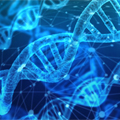1. Introduction
The lipid-bilayer shell of vesicles, or liposomes, has been widely studied as a model for cell membranes [1,2] and for applications such as drug delivery and cosmetics (see for example, [3,4,5]). Their aqueous environments, whether in vitro or in vivo contains a variety of potential degradation agents—from free radicals to acids or enzymes. Indeed, the utilization of liposomes for applications such as drug delivery often rely on release triggered by bilayer degradation through a chemical reaction induced by some unique marker of the target environment [6,7,8,9,10,11,12,13]. For example, differences in pH between some types of tumors and typical physiological conditions have been used to develop targeted, pH-triggered systems [14,15,16].
Studies of environmental-induced release from liposomes focus on the specificity of release, namely, on demonstrating that release is suppressed except at the target conditions [16,17,18]. Shell degradation is inferred by measuring the rate of release of encapsulated markers, and analysed either by assuming instantaneous shell elimination, or by assuming it has a permeability that is uniform and unchanging with time [19,20,21]. Little is known regarding the process of lipid bilayer degradation, its time evolution and the effect of system conditions (e.g. liposome size, solution conditions) on the resulting pore formation.
Monte Carlo simulations are an effective method for modeling processes such as drug release from different types of nanoparticles (see, for example, [22,23,24,25,26,27,28,29]). The method allows explicit accounting for the spatial distribution of individual molecules (such as the degradation agents), their diffusion rate in solution and stochastics of reaction rates in a simplified and computationally- efficient manner. The system is set as follows (see Figure 1): A liposomes of size r0 is situated in a box with reflective boundary conditions, coated by a bilayer of "lipid" molecules (colored in red). The liposome contains a number of "drug" molecules (colored in green) that diffuse randomly in the core but cannot cross the intact bilayer. The box contains a fixed concentration of "degradation molecules" (blue) that move randomly in the box. When a degradation molecule encounters a lipid, a degradation reaction may occur depending on a reaction probability. If the reaction does take place, the bilayer surface site (lipid molecule) it reacted with is eliminated. Encapsulated molecules that reach a degraded bilayer location are allowed to "escape". In each time-step, the fraction and distribution of intact bilayer is calculated, as well as the fraction of encapsulated compound remaining in the liposome.
Varying the liposome size, concentration of degradation agents in solution, and the probability of reaction allows determination of the effects of these parameters on the process.
2. Simulation Method
Monte-Carlo simulations are designed to model stochastic processes where the behavior of any individual constituent is random [30]. They are ideal for simulating diffusing molecules whose path follows a "random walk". In the 3D simulations performed here, the solvent (water) is taken to be a continuous medium, through which drug or reactive compound molecules move, in every time step Δt a unit distance (λ) in a randomly-determined direction in the three-dimensional box (see Figure 2). Thus, over long time it moves in a random walk, and the system follows Fick's diffusion law. Δt and λ differ from one system to another, but can be related to each other through the average velocity of a molecule, which is equal to λ/Δt, and the diffusion coefficient of the molecules in the medium, given by D ≈ λ2/3Δt (in three dimensions) [31].
Similarly, MC simulations can take into account the stochastic probability of a chemical reactions [30]: Like diffusion, chemical reactions are a Markovian process on the individual molecule level. The probability that two molecules that come within the an interaction range of each other will react depends on the height of the energy barrier to reaction. If the energy barrier is low (or the system temperature is high), the probability is high that a reaction will occur (although not necessarily 100%). If the energy barrier is high, the probability is low. Thus, a random number can be used to determine whether a specific molecule will react or not, making it a stochastic process on the molecular level (as indeed it is). However, in large systems the aggregate behavior leads to the typical kinetics of reactions [30]. All species in the following simulations are taken to be uncharged point-like particles, so that electrostatic interactions are not accounted for. This is a relatively good approximation to physiological systems, where the Debye screening length that sets the rage of electrostatic interactions is of order 1nm, or even less near charged surfaces [31].
In the simulations, length-scales such as the size of the particle are given in terms of λ, the distance travelled by a molecule in a time step Δt, which also defines the lattice size in the simulations: Therefore, a liposome with radius r0 is one with a size of r0λ. Time (t) represents the number of time steps taken up to that point.
Simulations accounted for three regions, as shown in Figure 1:
(1) The nanoparticle- a 3D sphere of size r0 that contains a number of encapsulated "drug molecules". The drug molecules diffuse freely through the internal volume, but are reflected when encountering the shell. r0 values varied between 5 and 40 in simulation units.
(2) Bilayer shell.
(3) The solution- a box (with the particle center located at 0, 0, 0) that contains mobile degradation "molecules" representing species such as enzymes that can erode the nanoparticle shell. The concentration of degradation molecules is fixed, defined by the number of molecules per unoccupied unit volume of the system (namely, box volume -particle volume). The degradation molecules move randomly in solution, obeying a reflecting boundary condition at the box boundary.
The approach is based on our previous work [24,25,26,32] and is as follows:
In every time step, each degradation molecule is moved randomly in the box volume. As noted above, if it ends up at the box boundary it is reflected back, thereby maintaining a constant concentration (mimicking an infinite solution). If the molecule ends up on an occupied bilayer site, the probability of a degradation reaction in this case, pm, is randomly assigned and compared to a pre-defined probability value p. If pm ≥ p, the reaction occurs, if not, the degradation molecule "bounces" to its previous position without reacting. The value of the pre-assigned probability p defines the rate of reaction: p = 0 means that no reaction occurs, p = 1 means that the reaction always occurs (note that p = 0 means an infinite reaction time, and p = 1 an instantaneous one, so intermediate values mean an intermediate rate). If a reaction is determined to take place, the lipid shell site is eliminated and the degrading molecule is placed at the box boundary (thereby maintaining a constant concentration).
In each time step all drug molecules are also moved randomly by one step inside the liposome core. If the drug molecule lands on an intact shell site, it is reflected back into the core. However, if it lands on a reacted shell site it is allowed to remain. Drug molecules that cross into the solution environment are eliminated (simulating an infinite sink).
Various statistics are calculated in each time step, including Φd (t), the fraction of drug molecules remaining in the core after t time steps, and the fraction of remaining bilayer sites Φs (t).
Test runs (not shown) find that the number of encapsulated drug molecules does not affect the release when presented in terms of fraction of encapsulated molecules remaining in the particle at any given time. Also, box length that exceed (1.5-2) r0 do not affect the process; therefore, all simulations were conducted in systems where the box size was at least 2r0 so as to simulate an infinite solution. Each case was run at least 3 times to provide an average and standard deviation. Runs conducted on "uncoated" particles yield a release profile that scales with 1/r02 as expected for release from an uncoated particle.
All runs and analysis were conducted using MathematicaTM.
3. Results
Bilayer degradation and the associated release from a liposome are shown in Figure 3. The area of the intact lipid bilayer is shown to decrease in a monotonic fashion (Figure 3A) that can be fit, relatively well, with an exponential decay. However, the release profile of the encapsulated drug (Figure 3B) has an initial "lag" in the release (lasting, approximately, 200 time steps in this case), with a resulting release profile that is different qualitatively from that of release from a similar where there is no surface resistance to transport of molecules out (or in) of the core—namely, when the interface between the drug-containing core and the surrounding solution is fully permeable.
The effect of liposome size on the degradation profile of the bilayer is shown in Figure 4; Liposome size is found to have a weak effect on the bilayer degradation rate, so that at any given (simulation) time, the fraction of intact bilayer remaining is nearly independent of r0. The actual area of bilayer remaining (Figure 4 inset) does depend on r0, as may be expected, but the time over which the entire liposome area degrades (namely, when Φs = 0) is independent of the liposome radius.
Both the rate of bilayer degradation reaction, p, and the concentration of degradation molecules in solution, C, are expected to affect the process of bilayer degradation. As shown in Figure 4, this is indeed the case. The effect of solution concentration (Figure 5A) is significant: The time required to degrade the entire shell (namely, Φs = 0) decreases from ~3500 time steps to ~200 as the concentration increases from 0.001 to 0.2. Similarly, in systems with the same concentration the reaction rate (which is inversely proportional to the probability of reaction) increases with increasing rate: The instantaneous reaction (p = 1) requires about ¼ of the time to degrade the shell than one with p = 0.1 (Figure 5B).
4. Discussion
Monte-Carlo simulations are applied to investigate the effect of system parameters on the degradation of a liposome's bilayer shell by environmental degradation agents. The bilayer degradation profile, as defined by the fraction of remaining (intact) shell as a function of time roughly follows a simple exponential decay profile, as shown in Figure 3A. This profile is similar to that of solid particle degradation [33] despite the significant differences in the two processes: In the case of liposomes, the bilayer is a thin shell that encompasses a fixed volume, while the degrading nanoparticle shrinks with time, thereby reducing the surface area available for degradation. This suggests that the dominant process in degradation is the availability and type (rate) of degradation reaction, rather than the characteristics of the degrading surface.
Indeed, comparing the degradation of bilayers for different-sized liposomes in Figure 4 shows that the rate, as defined by the decay in intact bilayer fraction with time or by the period of time required for complete degradation is independent of the liposome radius, r0. This is due to the fact that bilayer degradation is set by the reaction between the degrading molecules in solution and the bilayer surface. The probability, at any given time step, that a reaction will happen and a unit of the bilayer will degrade is proportional to the probability of reaction (p, which is held constant in these simulations) times the probability that a degradation molecule will encounter a unit of the (intact) bilayer. The latter is proportional to the concentration of degradation agents (C, held constant) per surface area of the liposome. As a result, the effect of the liposome size is negligible.
To better understand the effect of solution conditions on bilayer degradation, Figure 5 compares degradation in solutions with different concentrations of degradation molecules C (Figure 5A) and the probability of reaction, p (Figure 5B). As may be expected, the concentration of molecules has a significant effect on the time required to degrade the bilayers. The time scale for degradation, as defined either by the time required for Φs = 0 or by the exponential fit parameter (not shown) scales roughly with C, in agreement with the expectation that the degradation is dominated by the probability of "collision" between the degradation molecules and the bilayer (proportional to C). The probability of reaction p defines how frequently would a collision between a degradation molecule and the bilayer would lead to a reaction: p = 1 means that it will always occur, and corresponds to an instantaneous reaction. As p decreases, more collisions are required until a reaction will occur—thus increasing the reaction rate.
A simple model for the degradation of the bilayer shell can be presented as
leading to
where AB is the remaining intact bilayer area at time t, and A0 is the initial area. C is the concentration of degradation agents (which is held constant), and k, the reaction rate, is proportional to 1/p.
The main consequence of bilayer degradation is the associated release of encapsulated molecules: favourable if degradation is used to trigger release under specific conditions or locations, unfavourable when not. As shown in Figure 3B, the release from degrading liposomal bilayers displays a "lag" period that corresponds to the time required for (most) of the bilayer to degrade. As a result, the profile of the release and the time scales differ significantly from those obtained from particles without any shell (Figure 3B), as well as from a liposome subjected to an oscillating field where release occurs through pores that allow release open and close [24]. It is important to note, however, that in the systems discussed here release required the encapsulated molecules to cross from the liposome interior into the surrounding solution; while this is relevant to stagnant solutions, it may not be accurate for cases where the system is mechanically mixed, so that—when most or all of the liposome bilayer is removed—the encapsulated molecules are instantaneously released into the solution.
The results obtained in these simulations are based on assumption that the bilayer does not rearrange during the degradation process, namely, that pores formed by degradation do not "heal" with time. This assumption may seem questionable for bilayers in the liquid regime, where lateral mobility is relatively high. However, it is in agreement with experiments following liposome degradation, that find that the size and size distribution of liposomes was remains unchanged even when a large fraction of the lipids has been digested [34,35,36,37], supporting the premise that pores formed because of digestion do not heal, since that would cause a reduction in size.
The simulations presented here show that liposome size does not affect bilayer degradation. Therefore, when designing liposomes for various applications, choice of size can be set by the needs other considerations such circulation time in vivo or organ distribution [38,39]. However, choosing lipids that are degraded by a component whose concentration is low in the target environment, or where the reaction rate is slow, would extend the stability of the liposomes.
5. Conclusion
Monte Carlo simulations are used to examine the effect of system parameters on the degradation of liposomal bilayers. They clearly show that the degradation rate (as defined by either the characteristic time for complete bilayer degradation or by the profile of the remaining intact bilayer fraction as a function of time) is independent of the liposome size, but highly sensitive to the degradation agents: Their concentration and the type- or rate- of reaction. These results can be used when designing liposomes to either resist environmental degradation or to release the encapsulated molecules under specific reactive conditions.
Conflict of Interest
The author declares no conflicts of interest in this paper.









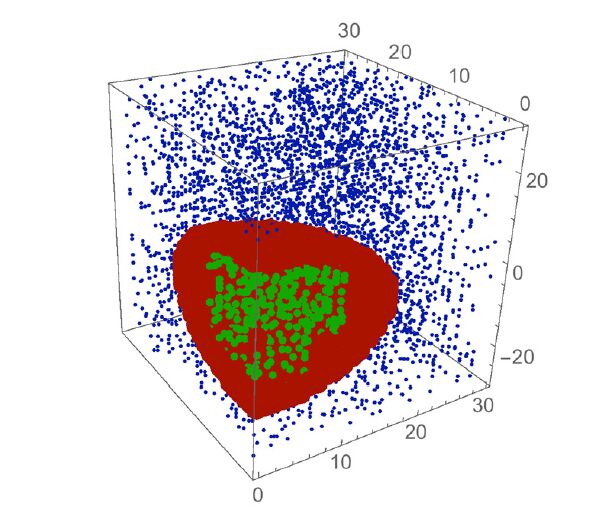
 DownLoad:
DownLoad: 